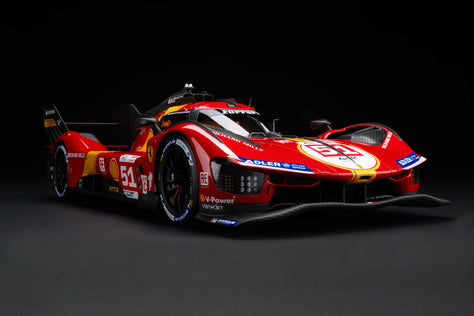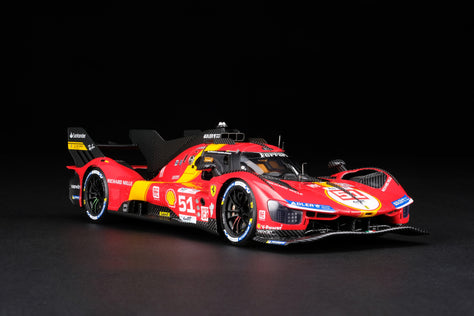技术详情
- 简介
- Scale guide
夺冠基因
虽然这辆车无疑是为了引领法拉利迈向未来而设计的,但 499P 这个名称唤起了马拉内罗制造商的历史,这种命名体系可以追溯到其之前的勒芒参赛车型。“499”指的是其发动机的单一排量,而“P”代表原型车。这款超级跑车的涂装也采用了与 1973 年的 312P 相同的颜色,作为对法拉利半个世纪前最后一次参与耐力赛的致敬,让人回忆起法拉利品牌与耐力赛核心竞争长久以来的联系。赛车的编号也是出于类似的原因确定的——数字“50”凸显了法拉利离开勒芒顶级组别已有多长时间,而数字“51”曾四次装饰在获胜的法拉利 GT 赛车上。
新型混合动力与创新技术
在定义 499P 时,法拉利凭借其代表马拉内罗品牌的庞大技术、专业和人力卓越资源,将管理工作委托给了 Attività Sportive GT,由安东内洛·科莱塔领导,并由负责运动和 GT 赛车工程与开发部门的负责人费迪南多·坎尼佐进行技术监督。尽管设计受到空气动力学和包装要求的限制,但它无疑仍是一辆法拉利,对于一辆纯粹在马拉内罗设计和制造的汽车来说这并不意外,在弗拉维奥·曼佐尼领导下的法拉利设计中心的支持下进行了精心打磨。这款车的技术和空气动力学特性通过简洁流畅的形状得到了增强:这是法拉利基因的明确表达。紧张的线条和流畅的表面之间的平衡,以一种未来感、纯粹且标志性的语言呈现,定义了一个清晰而简洁的架构。雕刻般的车身促进了空气通过侧箱的流动,冷却了隐藏在下面的散热器。轮拱的特点是有大型百叶窗,与大灯组一起为车头赋予了个性和表现力,微妙地参考了首次在法拉利 Daytona SP3 上引入的造型特征。车尾是技术、空气动力学和设计融合的终极表达;一层精致的碳纤维外壳覆盖了各种功能部件,使车轮和悬架完全可见。尾部的特点是有一个双层水平尾翼;主翼和上襟翼经过精心设计,以确保提供必要的下压力并实现最佳性能。下翼也有一个“灯条”,为后部设计增添了果断而简约的触感。
499P 基于全新的碳纤维单体壳底盘打造,采用了代表赛车运动技术前沿的解决方案。双叉臂、推杆式悬架提供了出色的减震刚度,在直线行驶和弯道行驶时都能感受到其优势。电子系统是从 GT 赛车领域积累的经验中发展而来,并进一步创新。这款超级跑车采用混合动力系统,将中后置动力单元与驱动前轴的电动机相结合,并与七速顺序变速箱相连接。所使用的 2.9 升双涡轮增压 V6 发动机与 296 GT3 及其公路版车型所使用的发动机相同,最大功率输出为 500 千瓦(680 马力)。此外还增加了一个与前轴相连的能量回收系统(ERS),由线控制动系统提供动力。ERS 的功率为 200 千瓦,为其供电的电池采用了法拉利在丰富的 F1 经验中积累的专业技术。499P 的 V6 发动机的一个特定特点是,与安装在竞赛 GT 赛车后副车架上的版本相比,该发动机是承重的,因此发挥了重要的结构功能。
比赛历史
法拉利 499P 由马拉内罗的技术人员和工程师在赛道上进行管理,并与赛车合作伙伴 AF Corse 合作,延续了自 2006 年开始的长期成功合作关系。在 2023 年国际汽联世界耐力锦标赛(WEC)赛季中,法拉利 GT 赛车手安东尼奥·福科、米格尔·莫利纳和尼克拉斯·尼尔森驾驶 51 号赛车,而两届 LMGTE Pro 世界冠军亚历山德罗·皮尔·吉迪和詹姆斯·卡拉多与法拉利一级方程式储备车手安东尼奥·乔维纳齐一起驾驶 51 号姊妹赛车。
备受期待的 499P 首秀在赛百灵 1000 英里耐力赛上,50 号赛车通过获得杆位确立了早期基准。然而,尽管从发车时处于领先位置,但法拉利还是被两辆丰田 Gazoo Racing 赛车超越,最终获得第三名,在法拉利重返原型车耐力赛之际登上了领奖台。最终,499P 常常被丰田赛车超越,丰田连续第五年获得冠军,但法拉利仍领先于其他制造商。在整个赛季中只有一次未能登上领奖台之后,法拉利 AF Corse 是日本车队唯一真正的挑战者,两辆赛车都将冠军争夺战带到了巴林的赛季总决赛。不过,本赛季的亮点出现在著名的勒芒 24 小时耐力赛上:50 号赛车再次在超级杆位赛中获得资格,但正是由皮尔·吉迪、卡拉多和乔维纳齐驾驶的 51 号赛车在一场激烈而戏剧性的比赛后成功重返萨尔特赛道。
在 2024 赛季,法拉利 AF Corse 推出了第三辆 499P:83 号赛车,由法拉利官方车手叶一飞、罗伯特·施瓦茨曼以及国际汽联世界耐力锦标赛 LMP2 冠军和一级方程式赛车冠军罗伯特·库比卡驾驶。又是在勒芒,499P 大放异彩:这次是由福科、莫利纳和尼尔森驾驶的 50 号赛车取得了完胜,为法拉利在该项赛事中赢得了第十一次胜利。在如今有九个不同制造商参与、竞争日益激烈的锦标赛中,该车队在与来自保时捷和丰田的参赛车队的较量中仍在为冠军而战。
2024 年 6 月 10 日和 11 日,勒芒 24 小时耐力赛
这些法拉利 499P 模型是 2023 年 6 月 10 日和 11 日在萨特赛道举行的勒芒 24 小时耐力赛中,Miguel Molina、Antonio Fuoco 和 Nicklas Nielsen、Alessandro Pier Guidi、James Calado 和 Antonio Giovinazzi 驾驶的 50 号和 51 号超级跑车的 1:8 比例完美复制品。继前一年姊妹车 51 号赛车取得成功之后,50 号赛车为法拉利赢得了第二次连续胜利,这也是该品牌 51 年来第二次亮相勒芒的精英级别比赛。
赛车场的发车格上有 62 辆车,来自九个制造商的创纪录的 23 辆超级跑车与 LMP2 赛车和新的 LMGT3 级别赛车一同竞争。赛场上有来自不同领域的 186 名车手,包括以前的勒芒冠军、前一级方程式赛车车手、当前的 NTT INDYCAR SERIES 赛车手以及 GT 赛车冠军。除了 51 号和 50 号赛车之外,法拉利 AF 科尔斯车队还派出了由罗伯特·库比卡、罗伯特·施瓦茨曼和叶一飞驾驶的黄色涂装的 83 号赛车。法拉利在激烈的竞争中来到勒芒,尽管拥有相当的比赛速度,但在超级跑车世界耐力锦标赛制造商积分榜上落后于丰田和保时捷。在排位赛中,保时捷的 6 号车获得杆位,凯迪拉克的 3 号车位居第二。法拉利的 51 号和 50 号赛车将从第三和第四位发车,驾驶 50 号车的富奥科特别沮丧,因为一面红旗结束了原本看起来非常有希望的一圈,而 83 号车只能排在第十二位。
从比赛一开始,法拉利赛车就展现出了速度。尼尔森驾驶的 50 号车和乔维纳齐驾驶的 51 号车在仅仅 13 分钟后就取得了领先。库比卡驾驶的 83 号车也以同样坚定的方式开始了比赛,迅速攀升至第五位。大约在比赛进行到两小时的时候,开始下雨,各车队被迫提前做出策略决定。包括红色涂装的法拉利赛车在内的几辆超级跑车早早地换上了雨胎。然而,83 号车的库比卡仍使用软质光头胎,在潮湿的条件下熟练地操控着赛车。随着赛道变干,施瓦茨曼接手驾驶并加速前进,他逐渐拉大了与追赶的 8 号丰田车和 5 号保时捷车之间的距离。大约在第六个小时的时候,雨又回来了,引发了又一轮的进站。这一次,83 号车换上了雨胎,并且再次完美地判断了赛道状况,每圈比一些对手快了多达 30 秒。然而,当时由库比卡驾驶的 83 号车随后与德里斯·范托的 15 号宝马车发生了碰撞,这位比利时车手在试图套圈时撞上了围墙。这起事故引发了长达九十多分钟的安全车时段,不久后赛事干事判定库比卡负有责任,对 83 号车处以 30 秒的进站罚停处罚,使 83 号车又回到了大部队中。在比赛进行到第九个小时的时候,50 号、83 号和 51 号法拉利三辆车分别排在第五、第六和第七位,落后于 8 号丰田车、6 号保时捷车、7 号丰田车和 2 号凯迪拉克车。深夜,由于持续的大雨和黑暗中的低能见度,赛事控制中心触发了长达近四个半小时的安全车时段。比赛在十六个小时刚过的时候恢复,50 号车排在第三位,83 号车排在第五位,它们在进站期间获得了位置提升。乔维纳齐驾驶的 51 号车保持在第七位,但很快因在全场黄旗期间速度不正确而被处以通过维修站的处罚。位置之争一直持续到又一个小时的安全车时段,这次是由 GT 级别中的一次严重撞车事故引发的,超级跑车再次聚集在一起。
离比赛结束还有七个小时的时候,仍有 11 辆车在领先圈,它们仍可以争夺胜利。雨停了,比赛竞争激烈,车辆们为了位置你争我夺:凯迪拉克损失了两辆车,3 号车因漏油而停驶,一次壮观的事故终结了 311 号凯迪拉克的希望;保时捷的 4 号车在印第安纳波利斯发生撞车后退出比赛,而 5 号和 6 号车则落后了。法拉利也未能幸免,83 号车带着从刹车处冒出的浓烟驶入维修站,随后被诊断出混合动力系统出现了致命问题。最终,这看起来像是去年决赛的重演,剩下的 50 号和 51 号法拉利与 7 号和 8 号丰田车展开了较量。然而,51 号车的皮耶尔·吉迪在穆尚弯道犯了一个错误,使 8 号丰田车打转,这位意大利车手被处以五秒的罚时。当尼尔森被迫将 50 号车驶入维修站,因为该车的右侧车门松动时,似乎优势进一步转到了丰田手中。在还剩五十分钟的时候,这次非计划进站本应使 499P 需要最后一次进站;但法拉利很有信心该车能够延长其燃油负载,当 7 号丰田车在不到十分钟后进行最后一次进站时,他们知道自己能够到达终点,而法拉利的这一策略将受到严格审查。二十分钟后,车队和车迷们越来越意识到法拉利打出了一记妙招,因为尼尔森熟练地操控着他的赛车冲过终点线,为法拉利赢得了连续第二个胜利,领先优势为 14.221 秒。尽管在最后受到了罚时,51 号车还是冲过了终点线,获得了最后一个领奖台位置,以仅仅 1.167 秒的优势在终点线上击败了从杆位出发的 6 号保时捷。这次胜利标志着跃马在这场经典的法国耐力赛中取得了第 11 次总冠军,加上 29 次级别胜利,总共获得了 40 次胜利。通过在第 92 届勒芒 24 小时耐力赛和摩纳哥一级方程式大奖赛上获胜,法拉利也是自 1934 年以来第一个在同一年在两项世界最负盛名的比赛中登上最高领奖台的制造商。
法拉利 499P 的 1:8 比例模型每种涂装限量 499 件。
--------------------------------------------------------------
这款模型是勒芒24小时耐力赛收藏品系列之一
预订
定制款
In order for us to create your bespoke model, you will need to choose 4 extra options. Paint colour, interior colour, wheel style and caliper colour.
Please complete the form and a member of our Sales Team will contact you.
联系我们
请与我们联系以获取有关订购此型号的更多信息。






